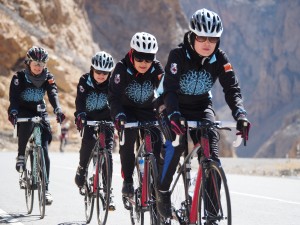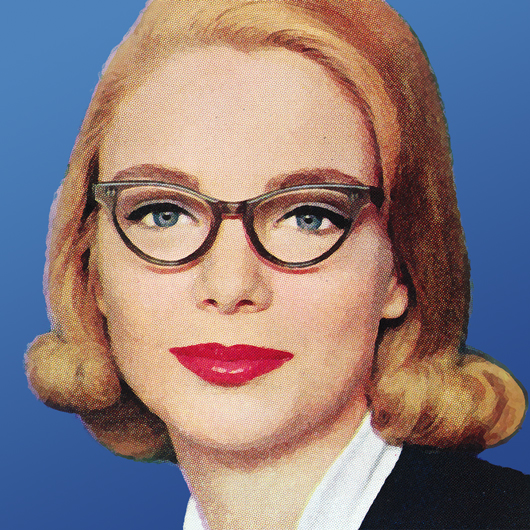
Welcome to our new feature, Kickass Women in History! This month’s Kickass Woman is Annie Cohen Kopchovsky, better known as Annie Londonderry. She bicycled around the world in 1895. She was the first woman to do it, and it took her fifteen months.
Annie was a Jewish woman born in what is now Lativa in 1870. She and her family immigrated to the US when Annie was quite young. She married Max Kopchovsky and they had three children. According to legend, Annie’s journey began when two businessmen made a wager that a woman could bicycle around the world in fifteen months. Annie, who was twenty-four at the time, agreed to be the woman to settle the wager. She would be paid $5000 if she made it. Then, the Londonderry Lithia Spring Water Company paid her $100 to change her name to Londonderry and carry a placard with the company logo on her ride. She started her ride in 1894 and concluded in 1895.
Annie was an excellent cyclist, as well as an excellent, if not always truthful, storyteller and businesswoman. She supported herself on her trip by lecturing about her life and her trip. During the course of her ride, Annie’s attire changed. She started her trip in regular women’s clothing. Partly through the trip she started wearing bloomers, and eventually took to wearing the standard cycling outfit worn by men.
I was inspired to write about Annie after I read the Victorian novel Miss Cayley’s Adventures, which deals in part with a Victorian woman who sells bicycles as she travels around Europe. Bicycling had an enormous influence on women’s rights in Europe and America. Bicycling improved women’s health, encouraged changes in their clothing, and increased their sense of freedom and independence. Susan B. Anthony said:
“I think [the bicycle] has done more to emancipate women than any one thing in the world. I rejoice every time I see a woman ride by on a bike. It gives her a feeling of self-reliance and independence the moment she takes her seat; and away she goes, the picture of untrammelled womanhood.”

The story of women and cycling is fascinating. People feared that it would damage women’s health and lead to immorality. People also feared that women would have lascivious sensations while riding bikes, which is why women’s handlebars were positioned in a more upright position than men’s. As bikes became more popular, corsets became less popular and bloomers and divided skirts were all the rage. Previously, the model woman was indoorsy and frail and could not expose her ankle. By the early 1900’s, women were openly exercising outdoors, ankles flashing in the wind, as models of the ‘New Woman’. While conservative forces railed against the bicycle, women persisted in riding.
Annie completed her trip in the required fifteen months. After the trip, Annie and her family moved to New York and Annie became a journalist. Among other things, she wrote about her trip under the byline “Nellie Bly, Jr.” (Nellie Bly had retired by then). She wrote,
“I am a journalist and ‘a new woman’ if that term means that I believe I can do anything that any man can do.“
Here’s some resources if you want to learn more about Annie Londonderry or about the link between cycling and feminism.
- AnnieLondonderry.com has tons of information about Annie and about the history of cycling.
- This article on BrainPickings has a hilarious list of “Do’s and Don’ts” for Women Cyclists, from 1895, including “Don’t be a fright,” and “Don’t cultivate ‘bicycle face.'”
I haven’t read these books, but you can bet they are on my TBR:
A Wheel Within a Wheel: How I Learned to Ride a Bicycle. Frances E. Willard. 1895
Around the World on Two Wheels: Annie Londonderry’s Extraordinary Ride. Peter Zheutlin
Bicycling for Ladies. Maria Ward, 1896
I was fascinated to find these articles about women’s cycling in Afghanistan, where cycling is bringing similar opportunities for women today, and where women are facing similar pushback:
- Biking Towards Women’s Rights in Afghanistan by Sarah GoodyearMen driving by insult them. Boys along the road throw rocks at them. Sometimes they don’t have enough money to buy adequate food to fuel their rides. Every day, they are reminded that it is taboo in Afghan society for a woman to get on a bicycle. And still they ride.

Photo: Shannon Galpin “They tell us that it is not our right to ride our bikes in the streets and such,” says Marjan Sidiqqi, one of the young women on the team. “We tell them that this is our right and that they are taking our right away. Then we speed off.”
- Mountain2Mountain supports the Afghan National Cycling Team, and also has a profile of their efforts and of the team’s significance.






My amazement at what women have been discouraged from getting up to purely as a protection against us feeling like women were intended to feel is, as ever, ongoing. The idea that in a good bit of the world it’s not changed or even gotten worse is a hard pill to swallow.
We like to think we’re past that sort of stupidity here in the West but we’ve got a long way to go yet. I can’t imagine we’ll achieve our goal in as little time as it took this woman to bicycle around the world.
That is Kick-Ass.
Excellent post! I’m liking this new feature
I love love love this post and concept! When I was doing my degree in history I often wondered why we weren’t looking more closely at the influence of women. Keep up the good work. I’m going to be sending these to my nieces so they can see that history isn’t all about “dead white dudes who were removed from the people”.
I have a friend who grew up in Belgium in the fifties and sixties who remembers rural Dutch women who had special “modesty” seats on their bikes, ovals that ran parallel (instead of perpendicular) to the handlebars, on a slant, similar to the seat of an ergonomic chair (so you could pedal with nothing between your legs). When she started commuting to a job where she had to wear pencil skirts (that were impractical to wear on a modern bike) she got one of those special old seats and pedaled happily away in her skirts!
The politics of bicycling generally are fascinating and far from a dead issue. I’d say generally that the racing bike with dropped handlebars is incredibly inconvenient and uncomfortable for commuting (and I find that design makes my lower back hurt if I ride it for a prolonged period, especially with panniers), so the raised handlebars of the commuter bike are a great invention. Interesting that the use of the bicycle as a form of transportation as opposed to for racing is linked to women’s cycling. I know in the 1920s in Holland there was a campaign to make people see cycling as a “manly” form of transportation, and that might well be why. The results, as anyone who’s visited the Netherlands knows, are an unparalleled network of bicycle lanes which seriously cut down on pollution and congestion in urban areas, and effectively promote public health, since everyone cycles. Maybe tagging bikes as exclusively an instrument of women’s freedom actually had some negative side effects…
I’m currently working on a book on the history of the Jewish Mother stereotype (and why it’s WRONG, and why Jewish Mothers are the under-heralded reason Jews have been so inordinately successful throughout history and despite anti-Semitism and expulsions from country after country) and there’s a big chunk on Annie Londonderry! LOVE HUH.
Fascinating! I knew about Frances E. Willard, but I didn’t know about Ms. Londonderry. Thank you for sharing this.
Thanks for the article. I enjoyed reading about this woman. I knew nothing about her. I’m not from the U.S., which may explain this omission. And yet, we owe so much to adventurers and champions like her.
For a wonderful film about a contemporary yearning for a bicycle, see Wadjda, which is about a young girl from Saudi Arabia. The Director and Screenwriter, Haifaa Al Mansour, is a talented young woman and the cast is fabulous. It is amazing that the film was ever made.
Wadjda (2012)
An enterprising Saudi girl signs on for her school’s Koran recitation competition as a way to raise the remaining funds she needs in order to buy the green bicycle that has captured her interest.
Love the post, and am looking forward to the next one in the series. Marjorie – can’t wait to read your book when it is published.
I can’t thank you enough for this post! I love biking even more than romance novels. I shared it with a women’s biking advocacy biking group I belong to and they all loved it! Biking = women’s rights! So awesome.
This feature is a great addition to the blog. Thank you, thank you!!
@Turophile:
I loved this post, too, especially because for me as a kid, riding my bike was my first taste of autonomy (which I LOVE), and because where I live now, the drivers and the amount of distractions make it very hazardous for bikers, especially kids. I envy the cultures that have valued biking as a means of transportation and made it so safe. This feature was Carrie’s idea, and I love it – way to go Carrie!
@Marjorie: YOUR BOOK IS GOING TO RULE. Go go go! I cannot wait to read it. Signed, Officially Licensed Jewish Mother. 🙂
[…] many of you know, I’ve recently started a project at Smart Bitches, Trashy Books called “Kickass Women in History”. This month, I write about Annie Cohen Kopchovsky, […]
I read a book Wheels of Change: How Women Rode the Bicycle to Freedom (with a Few Flat Tires Along the Way) Author: Macy, Sue. It is written for younger audiences with many illustrations, but I still found it interesting. It touches on the freedoms that bicycles gave women, including women of color, and are still giving women. One current example was giving bicycles to poor girls in non-industrial countries gives them enough time to do their chores then bike to school. If they had to walk the miles to school, they wouldn’t have been allowed that time off from chores.
Sarah, thank you!!! And Rebecca, I really liked that Sue Macy book too (even though my actual children wanted nothing to do with it). The design is so good, with so many vintage illustrations and photos and postcards, I think it works almost better as a coffee-table book than as a kids’ book.
Y’all should really see the “Velocipedestrienne” shirt by Kate Beaton. (She writes the web comic, Hark! A Vagrant.) Seriously. You will <3 it so much. Do a Google image search for "hark a vagrant ain't give a damn" for the T-shirt, or see the comic that inspired the shirt here: http://www.harkavagrant.com/index.php?id=331
[For the record, I am in no way connected to KB or her website, and do not profit from this comment in any way. I just think her work is awesomesauce.]